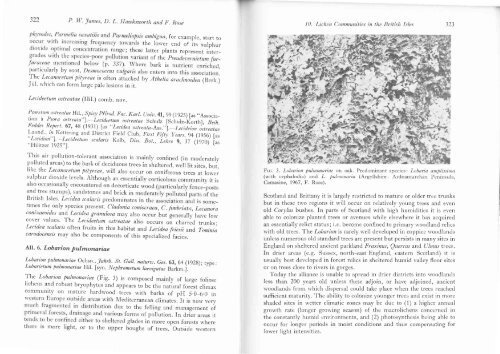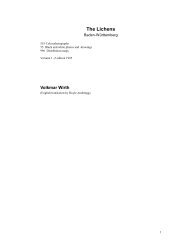Lichen communities in the British Isles: A preliminary conspectus
Lichen communities in the British Isles: A preliminary conspectus
Lichen communities in the British Isles: A preliminary conspectus
Create successful ePaper yourself
Turn your PDF publications into a flip-book with our unique Google optimized e-Paper software.
322 P. W. James, D. L. Ilawhsworth and F. Rose<br />
ambigua, for examplc, start to<br />
he lower end o{ its sulphur<br />
latter plants represent <strong>in</strong>ter_<br />
of <strong>the</strong> Psea<br />
bark is nu<br />
particularly by soot, Desmococcus enters <strong>in</strong>to '<br />
-rhe Lecanoretum pityreae is often tacked by A<strong>the</strong>ria arachnoidea (Berk.j<br />
Jtil. which can form large pale lesions <strong>in</strong> it.<br />
Lecideetum ostreatae (Hil.) comb. nov.<br />
Psoretum ostreatae Hil., sp^y pfirott. Fac. Karr. Llnht.4l,gg (lgzs)[as .,Association<br />
d Psora ostreata"f.-Lecidceturn ostreatae schulz 1s"n.,u-rtorth], Beih.<br />
leddes Refert. 67, +8 (1931) las ,,Lecidea ostreata_Ass.,,j._Lecideion ortreata,<br />
!3"".{,, <strong>in</strong>_Ketter<strong>in</strong>g and Disirict Field Club, First Fifty years,94 (1956) [as<br />
"Lecidion"l.-Lecideetum scalaris Kalb, 1)zss. Bot., Lrh* g, '37 (1970) [as<br />
"Hilitzer 7925"1.<br />
This air pollution-tolerant association is ma<strong>in</strong>ly conf<strong>in</strong>ed (<strong>in</strong> moderately<br />
polluted areas) to <strong>the</strong> bark of deciduous trees <strong>in</strong> shelterecr, wJll lif .sites, but,<br />
Iike <strong>the</strong> Lecanoretum pitl,reae, will also occllr on coniferous trees at rower<br />
sulphur dioxide levels. Although an essentia<br />
also occasionally encountered on decorticate<br />
and tree stumps), sandstones and brick <strong>in</strong> m<br />
<strong>British</strong> IsIes. Lecidea scalaris predom<strong>in</strong>ates i<br />
times <strong>the</strong> only species present. cradonia coniocreea, c. fimbriata, Lecanore<br />
conizaeoides and Lecidea granurosa may arso o..rrr'butlenerallf ha'e low.<br />
cover values. 'rhe Lecideetum ostreaiae also occurs on charred trunks;<br />
Lecidea scalaris often fruits <strong>in</strong> this habitat aod. Lecidea friesii ani Ton<strong>in</strong>ia<br />
carodocensis may also be components of this speciali""j fnci...<br />
All. 6. Loborion pulmonariae<br />
Lobarion pulmonariae Ocl.rsn., Jahrb. St. Gall. naturw. Ges. 63, 64 (192g); type:<br />
Lobarietum pulmonariae Hil. [syn. Nephrometum laeoigatae nr.f.rn.j. --<br />
'lhe Lobarion pulmonariae (Fig. 3) is composed ma<strong>in</strong>ly of large foriose<br />
lichcns and robust bryophytes ancr'appears io bc <strong>the</strong> ,atrr."l fore-.st climax<br />
community on mature harirwood i.... ,uith barks of pH i.-o-o.o i,<br />
diterranean climates. ft is nou, very<br />
to <strong>the</strong> fell<strong>in</strong>g and management of<br />
forms of pollution. In drier areas it<br />
<strong>the</strong>re is more light, or to <strong>the</strong> "on.,ofiio*i'.t:ri:::Jt3t,H:T.ix<br />
10. <strong>Lichen</strong> Communities <strong>in</strong> <strong>the</strong> <strong>British</strong> <strong>Isles</strong> J Z.'<br />
FIc. 3. Lobayion pulmonariae on oak. Predom<strong>in</strong>ant species: Lobaria amplissima.<br />
(with cephalodia) and L. pultnonaria (Argyllshire: Ardnamurchan Pen<strong>in</strong>sula,<br />
Camas<strong>in</strong>e, 1967, F. Rose).<br />
Scotland and Brittany it is largely restricted to mature or older tree trunks<br />
but <strong>in</strong> <strong>the</strong>se two regions it wlll occur on relatively young trees and even<br />
old Corylus bushes. In parts of Scotland with high humiditics it is even<br />
able to colonize planted trees or avenues while elservhere it has acquired<br />
an essentially relict status; i.e . become conf<strong>in</strong>ed to primary rvoodland relics<br />
with old trees. The Lobarion is rarely well developed <strong>in</strong> coppice s,oodlands<br />
unless l)umerous old standard trees are present but persists <strong>in</strong> many sitcs <strong>in</strong><br />
Enp;land on sheltered ancient parkland Fraxiruts, Quercus and (Jlnrus trees.<br />
In drier areas (e.g. Sussex, north-east England, eastern Scotland) it is<br />
usually best developed <strong>in</strong> forest relics <strong>in</strong> sheltered humid valley floor sitcs<br />
or on trees close to rivers <strong>in</strong> gorges.<br />
Today <strong>the</strong> alliance is unable to spread <strong>in</strong> drier districts <strong>in</strong>to rvoodlands<br />
less than 200 years old unless <strong>the</strong>se adjo<strong>in</strong>, or have adjo<strong>in</strong>ed, ancient<br />
woocllands from rvhich dispersal could take place when <strong>the</strong> trees reachcd<br />
sufficient maturity. The ability to colonize younger trecs and exist <strong>in</strong> more<br />
shaded sites <strong>in</strong> wetter climatic zones may be due to (1) a higher annual<br />
growth rate (longer grow<strong>in</strong>g season) of <strong>the</strong> macrolichens concerncd <strong>in</strong><br />
<strong>the</strong> constantly humid environments, and (2) photosynthcsis be<strong>in</strong>g able to<br />
occur for longer periocls <strong>in</strong> moist conditions and thus compensat<strong>in</strong>g for<br />
lower light <strong>in</strong>tensities.





